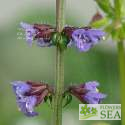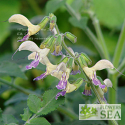(Purple & Yellow Yunnan Sage or ji ye shu wei cao) Confusion about this plant's scientific name cause it to appear in some sources as Salvia flava var. megalantha. Whatever you call it, this Chinese species from Yunnan Province has enchanting yellow and purple flowers that attract viewers as well as honeybees.
In Pinyin -- a phonetic version of Chinese -- "shu wei cao" means "sage" and "ye" is "leaf." The most likely meaning of "ji" is "several." So perhaps another common name for this sage should be "Many Leafed Sage". It makes sense, because the flower spikes rise up from a thick basal clump of deeply wrinkled, soft, fuzzy foliage.
English botanist Reginald John Farrer (1880-1920) collected Salvia bulleyana and named it for Arthur K. Bulley, a cotton broker who helped finance two of Farrer's plant expeditions.
Salvia bulleyana prefers partial shade and tolerates extreme cold as well as heat. This is a water-loving sage, but does fine with average watering based on local rainfall. As with so many Asian perennial sages, it fits well in a shady woodland garden but doesn't tempt deer.
A 2012 study published in the International Journal of Molecular Sciences notes that Salvia bulleyana is one of a number of Chinese sages containing tanshinones, which are plant chemicals that may prove useful in fighting cancer.
Question?








